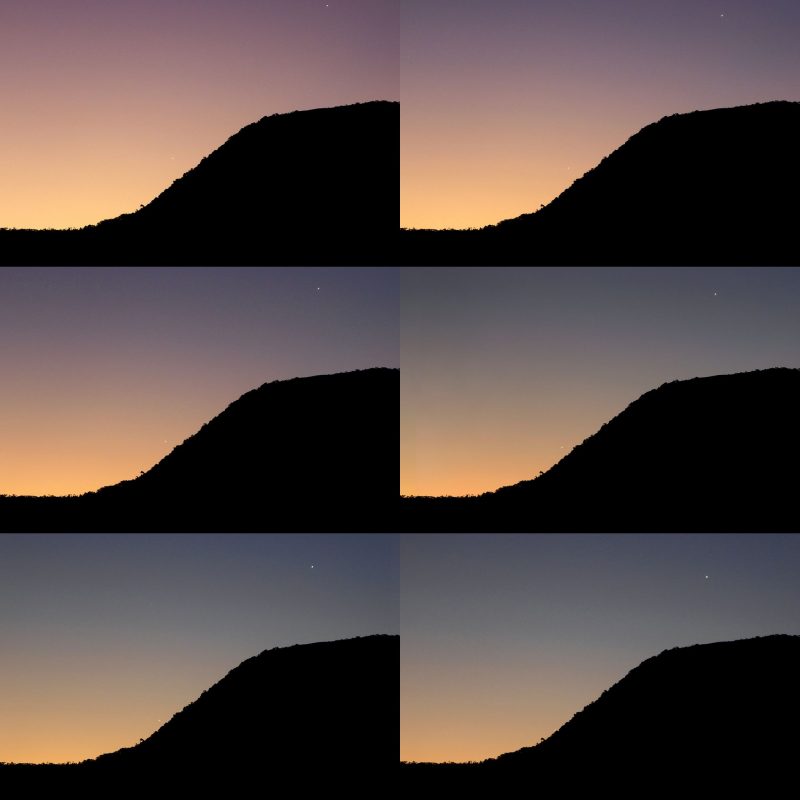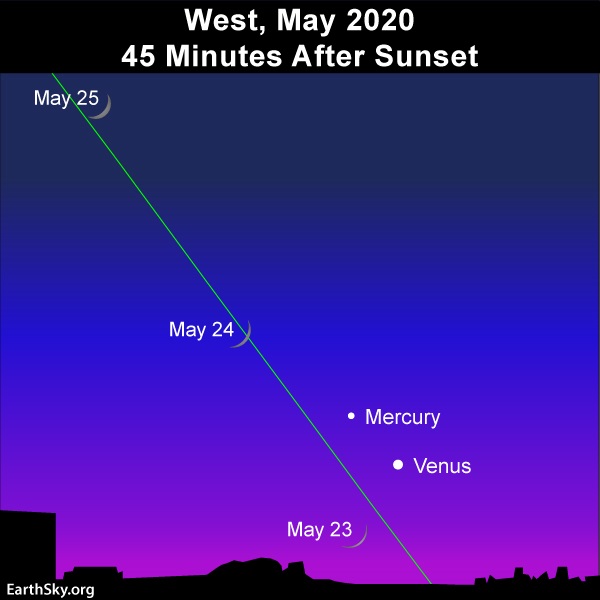The sun’s innermost planets, Mercury and Venus, will pair up in the west after sunset – their closest pairing for all of 2020 – visible in your sky on May 21 or 22. These two worlds will pass within only one degree on the sky’s dome. That’s approximately the width of your little finger held at arm’s length. Their pairing takes place low in the western twilight sky, shortly after sunset. Bright twilight will make Mercury hard to see. But Venus is very bright. Its brightness will pierce the twilight, making Venus an interesting and beautiful object to see now. Plus Venus can help you find and identify Mercury.
The actual conjunction of these two objects occurs on May 22 at around 07:00 UTC. That is when Mercury sweeps 0.9 degrees south of Venus on our sky’s dome. The time of the conjunction is a whole-Earth event, happening at the same moment for everyone. Meanwhile, for all of us on Earth, Venus and Mercury are visible low in the west after sunset on the evenings around May 21 and 22. You can keep watching them (or try to) through the end of this month.
To witness the unfolding of this grand celestial event, find an unobstructed horizon in the direction of sunset. As twilight deepens into darkness, watch for Venus to pop out 1/2 hour (or sooner) after sunset. Given clear skies, it’ll be hard to miss Venus, as it’s the third-brightest celestial body to light up the heavens, after the sun and moon, respectively. Luckily, Venus is our ticket to catching Mercury.
Although Mercury pales next to Venus, Mercury still shines as brilliantly as a 1st-magnitude star. Forty-five minutes to one hour after sunset, you may well be able to spot Mercury with the eye alone. If you can’t see Mercury otherwise, aim binoculars at Venus to view Mercury and Venus in a single binocular field.
By the way, these objects are moving rapidly on the sky’s dome with respect to each other. Your perspective on them also shifts as seen from various parts of the globe. Try Stellarium-Web for a precise view from your location. And – no matter where you are – you can recognize Mercury on May 21 and 22 as the brightest object near Venus in the evening twilight.
Just be sure to catch them not long after the sun goes down.

The Northern Hemisphere has the advantage for watching Mercury and Venus, because these two worlds set later after the sun as seen from northern latitudes. We give Venus’ approximate setting time at various latitudes for the evenings around May 21 and 22, 2020, given an absolutely level horizon:
60 degrees north latitude:
Venus sets 2 1/2 hours after the sun40 degrees north latitude:
Venus sets 1 1/2 hours after the sunEquator (0 degrees latitude):
Venus sets 1 1/4 hours after the sun35 degrees south latitude:
Venus sets one hour after the sun

Day by day, relative to the setting sun, Mercury will climb upward whereas Venus will fall downward. In a few more weeks – June 3, 2020 – Venus will transition out of the evening sky and into the morning sky. Mercury, on the other hand, will reach its greatest elongation from the setting sun on June 4, 2020. Over the next two weeks, watch for Venus to set sooner after sunset daily, while Mercury (though fading somewhat each day) stays out longer after sunset daily. After Mercury reaches its greatest elongation from the sun on June 4, 2020, it’ll fall sunward once again, to transition out of the evening sky and into the morning sky on July 1, 2020.

Even though Mercury and Venus appear close together on the sky’s dome, they are not truly close together in space. These two words only reside near the same line of sight. Look above at the diagram of the inner solar system (Mercury, Venus, Earth and Mars). At present, Mercury is more than three times Venus’ distance from Earth. Astronomers often measure solar system objects in terms of the astronomical unit (one Earth-sun distance). At their conjunction on May 22, 2020, at 07:00 UTC, Mercury is one astronomical unit and Venus is 0.3 astronomical unit distant from Earth.
As awesome as the Mercury/Venus pairing will be on May 21 and 22, 2021, more celestial drama is yet to come. Watch for the young waxing crescent moon to join up with these bright planets for several days, centered on or near May 24, 2020. See sky chart below.

Bottom line: For the Northern Hemisphere, late May/early June 2020 presents the best chance to see Mercury in the evening sky for the rest of 2020. From the Southern Hemisphere, Mercury will be harder to see, more deeply buried in evening twilight. No matter where you are on Earth, trying using Venus to find Mercury on May 21 and 22, 2020!











